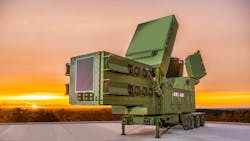Raytheon to upgrade LTAMDS missile-defense radar to handle advanced threats like hypersonic munitions
REDSTONE ARSENAL, Ala. – Missile defense experts at Raytheon Technologies Corp. will carry out upgrades and technology insertion to a new radar system to help defeat quickly evolving missile threats such as hypersonic weapons.
Officials of the U.S. army Contracting Command at Redstone Arsenal, Ala., announced a $122 million three-year contract Tuesday to the Raytheon Missiles & Defense segment in Andover, Mass., for the Lower Tier Air and Missile Defense Sensor (LTAMDS) pre-planned product improvement Increment III upgrades effort.
Raytheon won a U.S. Army contract in October 2019 to provide the next-generation LTAMDS advanced air and missile defense radar.
LTAMDS is the next generation, 360-degree missile-defense radar that ultimately will replace the current U.S. Army's Patriot missile radars. The radar has gallium nitride components,and is scheduled to reach initial operational capability with the Army in 2022.
LTAMDS consists of a primary antenna array on the front of the radar, and two secondary arrays on the rear. The radar antennas work together to enable operators to detect and engage several threats simultaneously from any direction, ensuring there are no blind spots on the battlefield.
The LTAMDS primary array is roughly the same size as the Patriot radar array, but provides more than twice Patriot's performance. While it is designed for the U.S. Army's Integrated Air and Missile Defense system, LTAMDS will also be able to preserve previous Patriot investments.
Raytheon is working with hundreds of suppliers across 42 states, including a core team playing a strategic role in building the LTAMDS solution.
Orolia USA in Rochester, N.Y., for example, is providing the company's rugged SecureSync time and frequency system to supply positioning, navigation, and timing (PNT) capability to the U.S. Lower Tier Air and Missile Defense Sensor (LTAMDS) radar program.
Crane Aerospace & Electronics in Lynnwood, Wash., is providing defense power systems for power control and conditioning for LTAMDS. Mercury Systems Inc. in Andover, Mass., is providing high-performance digital signal processing and RF solutions for LTAMDS.
On this contract Raytheon will do the work in Huntsville, Ala.; Tucson, Ariz.; Anaheim Hills, El Segundo, and San Diego, Calif.; Fort Walton Beach, Indialantic, and St. Petersburg, Fla.; Fort Wayne and Indianapolis, Ind.; Andover, Burlington, Cambridge, Marlborough, Tewksbury, Waltham, and Woburn, Mass.; Aberdeen Proving Ground and Fulton, Md.; Saginaw, Mich.; Nashua and Pelham, N.H.; White Sands Missile Range, N.M.; Lawton, Okla.; Chambersburg, Pa.; Portsmouth, R.I.; El Paso and San Antonio, Texas; and Arlington and Sterling, Va., and should be finished by October 2025.
For more information contact Raytheon Missiles & Defense online at www.raytheonmissilesanddefense.com, or the Army Contracting Command-Redstone at https://acc.army.mil/contractingcenters/acc-rsa.
About the Author
John Keller
Editor-in-Chief
John Keller is the Editor-in-Chief, Military & Aerospace Electronics Magazine--provides extensive coverage and analysis of enabling electronics and optoelectronic technologies in military, space and commercial aviation applications. John has been a member of the Military & Aerospace Electronics staff since 1989 and chief editor since 1995.
